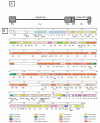Congenital cytomegalovirus infection: molecular mechanisms mediating viral pathogenesis
- PMID: 21827434
- PMCID: PMC3869401
- DOI: 10.2174/187152611797636721
Congenital cytomegalovirus infection: molecular mechanisms mediating viral pathogenesis
Abstract
Human cytomegalovirus (CMV) is responsible for approximately 40,000 congenital infections in the United States each year. Congenital CMV disease frequently produces serious neurodevelopmental disability, as well as vision impairment and sensorineural hearing loss. Development of a CMV vaccine is therefore considered to be a major public health priority. The mechanisms by which CMV injures the fetus are complex and likely include a combination of direct fetal injury induced by pathologic virally-encoded gene products, an inability of the maternal immune response to control infection, and the direct impact of infection on placental function. CMV encodes gene products that function, both at the RNA and the protein level, to interfere with many cellular processes. These include gene products that modify the cell cycle; interfere with apoptosis; induce an inflammatory response; mediate vascular injury; induce site-specific breakage of chromosomes; promote oncogenesis; dysregulate cellular proliferation; and facilitate evasion of host immune responses. This minireview summarizes current concepts regarding these aspects of the molecular virology of CMV and the potential pathogenic impact of viral gene expression on the developing fetus. Areas for potential development of novel therapeutic intervention are suggested for improving the outcome of this disabling congenital infection.
Figures



References
-
- Weller TH. The cytomegaloviruses: ubiquitous agents with protean clinical manifestations. I. N. Engl. J. Med. 1971;285(4):203–214. - PubMed
-
- Weller TH. The cytomegaloviruses: ubiquitous agents with protean clinical manifestations. II. N. Engl. J. Med. 1971;285(5):267–274. - PubMed
-
- Boeckh M, Nichols WG, Papanicolaou G, Rubin R, Wingard JR, Zaia J. Cytomegalovirus in hematopoietic stem cell transplant recipients: current status, known challenges, and future strategies. Biol. Blood Marrow Transplant. 2003;9(9):543–558. - PubMed
-
- Jacobsen MA, Mills J. Serious cytomegalovirus disease in the acquired immunodeficiency syndrome (AIDS): clinical findings, diagnosis, and treatment. Ann. Intern. Med. 1988;108(4):585–594. - PubMed
-
- Nigro G. Maternal-fetal cytomegalovirus infection: from diagnosis to therapy. J. Matern. Fetal Neonatal. Med. 2009;22(2):169–174. - PubMed

